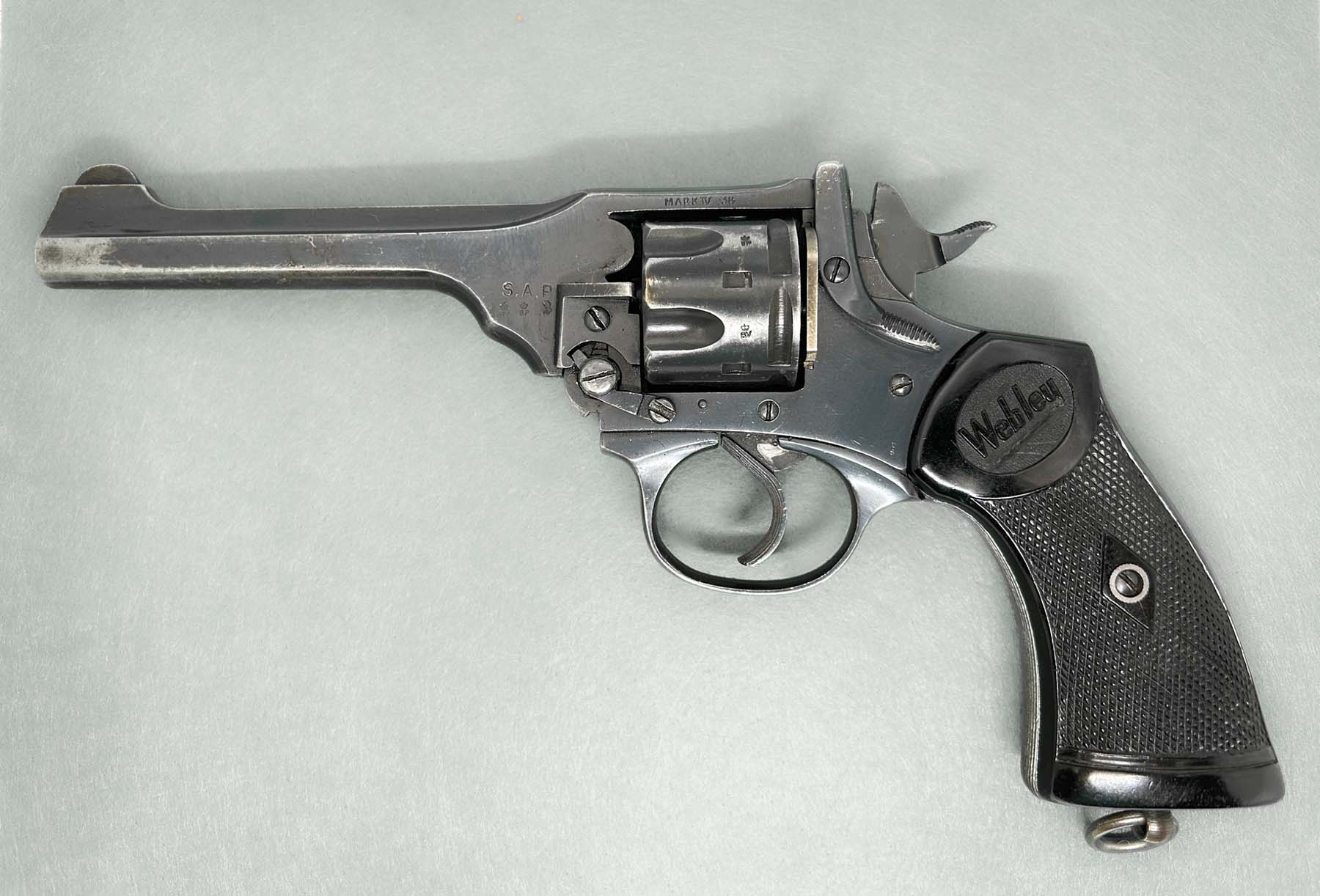If you like vintage British revolvers, the name Webley & Scott needs no introduction, since it supplied vast quantities of handguns for military and police service over many decades.
The Webley Mk VI top-break revolver in .455 Webley saw extensive use throughout WWI and while it was a very effective and reliable revolver, it was also a bit on the large side (both physically and recoil-wise) for what it needed to do.

After WWI the British Government decided to develop something smaller, and started looking around for a .38 revolver.
Aware of this, in 1928 Webley & Scott — having been the supplier of the British Government’s official service revolvers since the 1880s — offered an improved version of its existing .38 Mk III top-break revolver (not to be confused with the identically named revolver in .455 Webley), which they had originally developed in the late 1890s for police and commercial sales.
The resultant Webley Mk IV (also confusingly sharing its name with a .455 revolver introduced in 1899) was a top-break design with a 5in barrel and an overall weight of 1.6lb (about 760 grams).

It was chambered for the .38/200 cartridge (“Revolver, .380 in”), which was basically the .38 Smith & Wesson cartridge (not to be confused with .38 Special) loaded with a 200gn projectile travelling at about 630fps.
The gun was, in many respects, essentially a scaled-down version of the .455 Webley Mk VI service revolver, and so Webley & Scott not unreasonably figured its adoption was a formality.
Everyone was very surprised when, instead of adopting the Mk VI as the new sidearm and sending a cheque to the usual address, the British Government essentially reverse-engineered the pistol, came up with its own version called the Enfield No 2 Mk I, and declined to pay Webley & Scott for its work
The government insisted Captain Boys (of Boys .55 anti-tank rifle fame) had designed the Enfield revolver with a bit of assistance from Webley, not the other way around.

After much argument (almost certainly involving lawyers), Webley & Scott did eventually receive £1200 (about $A162,000 today) from the Royal Commission on Awards to Inventors – better than nothing but not exactly Government contract money either.
While the Webley & Scott Mk IV was not adopted as an official service pistol before WWII, a lot of them were still privately purchased by officers who were familiar with the firm’s reputation for quality. Many were also sold to police forces around the Empire at the time, particularly in Canada, Australia, India and South Africa.
A 1940 Parker-Hale catalogue lists the Webley Mk IV in .38 as costing £6, which works out at about $A800 today.
The .38/200 cartridge was soon found to be in potential breach of the Hague Convention regarding expanding projectiles for combat use, so in military use the pistols were fed with the .380in Revolver Mk IIz round, which fired a 178gr FMJ projectile at around 600fps.

Police and civilian shooters were under no such restrictions, however, and tended to load their guns with either the .38/200 load or the more common .38 S&W cartridge. Webley provided the guns with interchangeable foresights so the user could select the appropriate one for the ammunition.
Then World War II kicked off. The Royal Small Arms Factory at Enfield couldn’t keep up with demand for handguns, causing a mad scramble by the British military for whatever they could get, be it from British manufacturers or overseas suppliers via lend-lease.
Webley & Scott began supplying as many of its handguns as it could (stamped “WAR FINISH” so people would know the lack of polish wasn’t due to any quality standards drop by Webley), and large numbers of the Webley Mk IV were dropped to resistance units in occupied Europe.
Unsurprisingly, the revolver performed well and was reliable overall; the major issue was its atrocious double-action trigger pull of around 7.7kg (17lb) in double-action mode and up to 4kg (8.5lb) in single-action mode.
Commercial production resumed in 1946; the first major contracts were for the South African police and the Malayan police. In 1949, a .32 S&W Long version was introduced, generally with a 3in barrel for the security market — particularly banks, post offices, jewellers and the like. Some of the commercial market guns had shorter barrels — 4in versions were not uncommon.
Around the same time, a .22LR version began production, intended as a civilian target and recreational shooting handgun; these are a lot of fun to shoot and remain highly sought after by vintage handgun enthusiasts for obvious reasons.
The Webley Mk IV was in production from 1929-1982, although the last few guns delivered in 1982 were likely “new old stock” or made from existing parts at the factory from the 1970s.
The .38 S&W Webley Mk IV revolvers, loaded with modern factory ammo, fire a 145gn LRN projectile at around 650fps. As mentioned before, the trigger pull is extremely heavy, so it’s definitely not a precision target handgun.
Felt recoil is mild, but due to the short size of the case, unburnt powder can be an issue for reloaded rounds. Reloading for the cartridge is fairly straightforward when pistol powders are available, although the 145gn .357in LRN projectiles commercially available in Australia may be a touch undersized for the Webley’s bore, which often runs at about .360in.
Despite their age and vintage design, Webley Mk IV revolvers are still very capable handguns and popular with Service Match shooters.
More importantly, due to Australia’s laws regarding larger calibre handguns, they’re as close as most pistol shooters can get to shooting a WWI Webley Mk VI without a large calibre endorsement and access to a range running Metallic Silhouette matches.
The .38-calibre Webley Mk IV revolvers may not have the lightest trigger pull or be chambered in an affordable, plentiful cartridge, but they are distinctive, stylish, reliable and a lot of fun to shoot.

0 Comments